SX-A
A/C 42-8420 P-47D-5-RE. We have no details of the assigned pilot, but the aircraft was lost September 15, 1943 when Capt. Robert C. Durlin was forced to bail out.
A/C 42-74728 P-47D-6-RE. This aircraft shows up in Squadron records for the first time October 10, 1943. It appears to have been assigned to Capt. Charles J. Hoey. The aircraft left the Squadron (probably around the time D-15s came in February 1944) and went to the 495th FTG. Lt. Paul Fulton lost his life when he crashed in the aircraft August 24, 1944.
A/C 42-75707 P-47D-15-RE. This aircraft shows up on Squadron records for the first time on February 10, 1944 as part of the upgrade to D-15s. Capt. Charles J. Hoey flew SX-A on 28 missions between January and March 1944, but was assigned to Group in February 1944 and it is possible the aircraft then became the personal aircraft of Lt. Richard V. Keywan. He flew the aircraft on 50 missions between April and June 1944. Given his flight record and the famous photo it would seem very likely he was responsible for the name “Little Hotsy” rather than Hoey but we cannot state this to be known fact. Keywan lost his life when he was shot down in this aircraft June 12, 1944.

The famous photo of Lt. Richard V. Keywan in front of SX-A “Little Hotsy” (a/c 42-75707). Sadly the names of the two ground crew were not recorded.
A/C 42-26643 P-47D-25-RE. This aircraft joined the Squadron mid to late June 1944 and was the personal aircraft of Lt. William M. Newton Jr. who flew it on 46 missions between July and October 1944. Lt. Newton’s name for the aircraft “Aw Nuts” was, perhaps, appropriate for it was involved in an embarrassing taxiing accident at the hands of 2nd Lt. Edward C. Andrews on July 9, 1944. A picture of the aircraft artwork and damage is on p.518 of Jonah’s Feet Are Dry. A close look at that photograph indicates this was one of the camouflaged aircraft in the Squadron. The aircraft was still flying with the Squadron in September 1944 and was sent to the 509th FS, 405th FG when the 352nd converted to P-51s. It flew as G9-D “The Virgin” with the 509th and was damaged in a landing accident at R-68 Straubing June 4, 1945 while being flown by Lt. John H. Carroll.
A/C 44-14642P-51D-10-NA. This history of this aircraft is unclear in places. It was assigned to the 352nd in October 1944 and remained with the Squadron until after the end of the war. It was the only “A” coded P-51 in the Squadron flying 94 missions between October 1944 and April 1945 with 25 different pilots. The first assigned pilot was Capt. William C. Davis who flew the aircraft on 25 missions between October and December 1944. Davis completed his first tour in January 1945. We believe he named this aircraft “Aurora Houn Dog” and that his first aircraft was SX-A and not SX-V as is sometimes stated. The confusion arises because on his return to the Squadron Davis flew SX-V (a/c 44-72392) “Aurora Hound Dawg” – his old SX-A had by this time become the personal aircraft of Lt. Douglas A. MakiKuhna who named it “Miss Ethel” for his future wife Ethel Johnson. Makikuhna flew the aircraft on 29 missions between December 1944 and April 1945.
As a final word – the crew for SX-A throughout the war were S/Sgt Cecil C. Clark (Crew Chief), Sgt Horton (Assistant Crew Chief) and Sgt Murray H. Scheshko (Armourer). Horton does not show up on the original stateside roster for the Group so may have joined them later as a replacement. Clark and Scheshko were originally from “B” flight and transferred to “D” flight when it was formed in the spring of 1944 to cope with the increased number of Squadron aircraft. It really is a shame that so many of the official photos do not name the ground crews and this makes identification difficult. Let me know if you can confirm who is who…
There was, as far as we know from Squadron records, no use of SX-A Bar as an aircraft code.
SX-B
A/C 42-8446 P-47D-5-RE Unamed and assigned to Major William B. Bailey.
A/C 42-26036 P-47D-22-RE (see also SX-P). Unamed and assigned to Lt Col. William B. Bailey.
A/C 42-26459 P-47D-25-RE. Unamed while assigned to Col. Bailey and then “Butch II” when assigned to Lt. William T. McGarry.
A/C 44-14303 P51D-10-NA ‘Double Trouble.’ Personal Aircraft of Col. William B. Bailey. The aircraft was lost on February 3, 1945 after being hit by small arms fire. The pilot Major Leslie W. Seppala became a POW.
A/C 44-63684 P51D-20-NA ‘Double Trouble Two.’ Assigned to Col. William B. Bailey.

Col. William B. Bailey’s P51D-20-NA “Double Trouble Two” (a/c 44-63684)
A/C 44-15092 P51D-15-NA SX-B “Alabama Rammer Jammer.” Assigned to Lt. Arthur C. Cundy. After the loss of Cundy March 11, 1945 (see SX-D) the aircraft was flown by a number of pilots and most frequently on operations by Lt. James W. Lamb (MIA April 17, 1945 see SX-N). The aircraft was then assigned to Lt. William K. Bixby who presumably named it “Lulu Belle II.” It was salvaged after F/O Bowron’s crash on April 21, 1945.

Left to Right S/Sgt Edgar S. Welborn (Waggoner’s Crew Chief), Capt Waggoner, Lt Cundy and Sgt Schillinger.
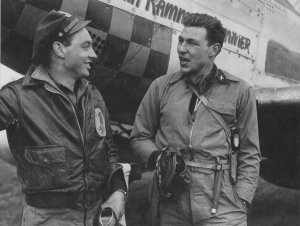
Capt. Horace Q. Waggoner with Lt. Arthur C. Cundy in front of Cundy’s “Alabama Rammer Jammer.” Cundy was lost heading out on a mission on March 11, 1945.

Lt. Arthur C. Cundy (second right) chats to the crew of a B-17 he has safely escorted home. Behind is SX-B bar (a/c 44-15092).
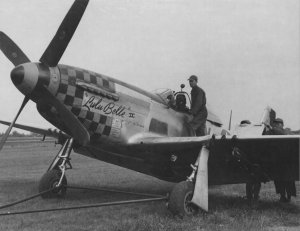
SX-B bar renamed as “Lulu Belle II” after F/O Everett B. Bowron made a heavy landing on April 21, 1945. If you look closely you can just see Lt. W. K Bixby as the assigned pilot.
A/C 44-14095 P51D-10-NA SX-B “Little Midget” (L) “Missy” (R). Assigned to Lt. James G. Bartley.
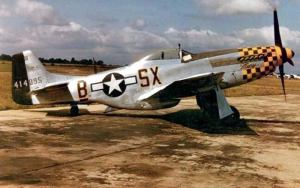
Bartley’s P-51D10-NA SX-B (bar) 44-14905 ‘Little Midget (L) ‘Missy’ (R)
SX-C
A/C 42-8531 P-47D-5-RE. This olive drab Thunderbolt appears to have come into the Squadron in early September 1943. Lt Col. Loren “Mac” McCollom took it as his personal aircraft and named it “Butch II” for his wife. As commander of the 61st FS, 56th Fighter Group, McCollom called his P-47 “Butch.” His daughter Patty explains that “Butch” was her father’s humorous nickname for her mother – a very diminutive, feminine and educated woman who you could never imagine calling “Butch.” When he left the 56th to join the 353rd, McCollom’s old P-47 would likely have remained on the 56th books and the natural thing to do would be to call the new 353rd aircraft “Butch II.” It seems that “Butch II” was disappointingly unreliable in the air. McCollom’s diary for the time recorded that “she’s a little rough I’m afraid” on September 7, 1943 and then “Butch II is still a little rough and not as fast as Butch” on the following day. McCollom’s frustration was evident in his diary entry for October 20 writing “[I] had to come back because she overheated. I’m going to have to give Butch II up. She’s just not dependable.” To add to these problems, Glenn Duncan had lost a wingtip from the aircraft in combat on September 23, 1943 so you can imagine that McCollom was probably not sorry to lose the aircraft.
After McCollom, the aircraft then became the assigned aircraft of Lt. Gordon L. Willits, but there are few records indicating that he ever flew it operationally. It did receive further battle damage while being flown by Major Bill Bailey on December 1, 1943. By the time records do become more comprehensive in January, 1944 it seems a variety of 352nd Squadron pilots flew it, but with no regular pilot it perhaps had a poor reputation in the Squadron. It last flew operationally with the Squadron on March 6, 1944 in the hands of Lt. Clifford F. Armstrong and probably left the Group soon after this date. There are no details about the ground crew for SX-C.
The aircraft shows up twice in subsequent accident reports after leaving the Group. The first is an accident at the hands of Reavy H. Giles while landing at RAF Woodchurch on April 23, 1944. The second was taxiing accident by Ansel J. Wheeler of the 373rd Fighter Group at Le Culot (A-89) on December 10, 1944.
Just as a final note on SX-C – the coding was only used once in the Squadron during the entire war. Inevitably this fact has brought some speculation that it was not used again as a tribute to Lt. Col. McCollom who was brought down by flak on the mission of November 25, 1943 to become a POW. This now seems unlikely to me as McCollom, it would appear, had given up the aircraft at some point in late October. Roger Freeman in his 56th Fighter Group (Oxford, 2000), p.21 also describes British Air Ministry recommendations not to use “C” in aircraft codes. This seems a much more plausible reason for the lack of “C” in the Group though I have no further information on this at this stage.
SX-D
A/C 44-14963 P51D-15-NA SX-D ‘Miss Jackie II’. Personal aircraft of Lt Lindsay W. Grove.
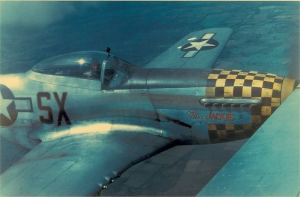
Lt Lindsay ‘Red’ W. Grove’s P51D-15-NA SX-D (bar) ‘Miss Jackie II’
SX-E
SX-F
A/C 42-7904 P-47D-1-RE. This olive drab Thunderbolt was an early aircraft with the Squadron. It was the assigned aircraft of Lt. Clifford F. Armstrong who named it “8 Gun Melody” Cross’s Jonah’s Feet Are Dry has an early picture of this aircraft (p.57) and a close-up of the artwork on (p.88). The aircraft continued in Armstrong’s hands, but was lost along with 1st Lt. Victor L. Vogel on January 11, 1944.

A well-known photo of Lt. Cliff Armstrong about to climb into his aircraft SX-F “8 Gun Melody” (a/c P-47D-1-RE 42-7904). Lt. Vogel was lost flying this aircraft January 11, 1944.
A/C 42-75622 P-47D-15-RE. This olive drab Thunderbolt was a replacement for Lt. Clifford F. Armstrong’s first aircraft. He named his second aircraft “Hun Buster” and flew it regularly until he completed his tour extension at the end of June 1944. There are two photographs of this aircraft in Cross’s Jonah’s Feet Are Dry (p. 208). The aircraft was then flown by a variety of Squadron pilots until assigned to F/O John J. Swanezy. He named the aircraft “Betty” and flew it throughout July and into August, 1944. Swanezy was killed in action while flying this aircraft on August 18, 1944. There is a nice colour photo of this aircraft available from the Jeff Ethel collection HERE though I have seen other versions of this photo but cannot establish who actually has the copyright. Although it does not appear that the Squadron flew another SX-F before converting to Mustangs, the records for September are missing so it can only be assumed that no further SX-F coded Thunderbolts existed.
A/C 44-14694 P-51D-10-NA. This Mustang was long-serving as one of the original aircraft assigned to the Squadron. The original pilot, Lt. Herbert F. Niklaus, flew it on 19 missions before completing his tour at the end of January, 1945. The aircraft was then taken over Lt. Albert P. Lang who named the aircraft “Eleanor” and flew it on 25 missions between January, 1945 and the end of the war. Tragically, 1st Lt. Edward A. Knickelbein lost his life in this aircraft after a mid-air collision and crash on July 3, 1945 near Stowmarket, Suffolk. There is a full account and pictures of the accident in Cross’s Jonah’s Feet Are Dry (p.624-625).
There are no SX-F bars recorded as flying with the Squadron.
As a final note on the crew for SX-F that flew as part of “B” Flight. The crew chief on the Thunderbolts was S/Sgt Joseph F. Brandon, Assistant Crew Chief was S/Sgt Raymond A. Wierzgacz and the armourer was Cpl. Earl A. Dunn. The crew for the Mustang period is unconfirmed and may have either changed entirely or in part. There is some evidence to suggest that Pvt. Joe Lopez may have been armourer at this time.
SX-G
A/C 44-14720 P51D-10-NA ‘Honey III.’ Personal aircraft of Major James N. Poindexter.
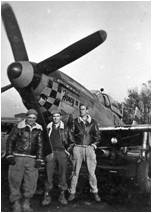
Major Poindexter’s “Honey III.”
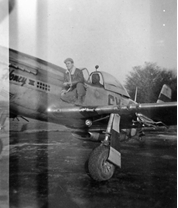
Major Poindexter’s “Honey III.”
SX-H
A/C 44-14674 P51D-10-NA ‘The Little Witch.’ Assigned to Lt. Donald W. Schoen.
SX-I
A/C 42-8390 P47D-2-RE. This was an olive drab razorback assigned to Lt. Robert P. Geurtz though he seems not to have ever named his aircraft. The aircraft was certainly with the Group at any early date (an oxygen leak and engine trouble forced the pilot to abort on the first two missions for the Group). There is an early photography of this aircraft on p.63 of Cross’s Jonah’s Feet Are Dry. Geurtz flew the aircraft on 34 missions in the period January to April 1944 (we don’t have details of the flights made in 1943). The Squadron sent the aircraft for salvage after Lt. Geurtz’s landing accident April 22, 1944.

The first SX-I (a/c 42-8390) after Lt. Robert P. Geurtz crashed on take-off after a tyre blew out April 22, 1944.
A/C 42-25771 P47D-22-RE.This was a natural metal finished razorback initially assigned to Lt. Donald J. Corrigan who flew it operationally three times between April 30 and May 20, 1944 (he completed his last mission on May 20 and left the Squadron May 24, 1944). His usual assigned aircraft was SX-P, but his son Kevin confirms that he told him he was assigned a “War Bond” plane and named it “Agony Wagon.” After Corrigan left the Squadron the aircraft was flown most often by Lt. Virgil C. Johnston who flew the aircraft on 20 missions between April and June 1944. He was lost in this aircraft on June 10, 1944 when it was brought down by flak while he was strafing Rennes airfield (MACR 5561 refers). There is a further photo of “Agony Wagon” on p.231 of Cross’s Jonah’s Feet Are Dry.
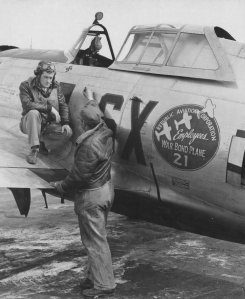
Lt. Donald J. Corrigan was the first assigned pilot to the second SX-I (a/c 42-25771) and called it “Agony Wagon.” The single kill marking indicates that it is his aircraft (Johnston had no kills) though the name has yet to be painted on the aircraft in this shot. The name of the ground crewman is unknown.
A/C 42-26631 P-47D-25-RE. A natural metal finished bubbletop assigned to Lt. William T. McGarry and named “Butch” by him. The aircraft name and “Butch II” (his later SX-B) is often mistakenly attributed to 352nd CO Bill Bailey. McGarry flew the aircraft on 34 missions between June and August 1944. The aircraft was brought down by ground fire near Dernancourt August 7, 1944. The pilot, Lt. Richard Daines, was killed in action (MACR 7444 refers).
A/C 44-19798 P47D-28-RE. A natural metal finished bubbletop assigned to Lt. Frank H. Bouldin and named “Miss Mary Marie” by him. The aircraft was flown on a handful of missions by Bouldin between August and September 1944 (the photo on p.233 of Cross’s Jonah’s Feet Are Dry confirms Bouldin as the assigned pilot). The aircraft is sometimes listed as P-47D-28-RA 42-28798, but we feel this is incorrect because 42-28798 was assigned to the 351st Fighter Squadron and 44-19798 shows up, as you would expect, in 352nd battle damage reports (see also the close-up photo of the serial below).The aircraft would have left the Squadron when they converted to the P-51 Mustangs.
N.B. Various sources on the internet state that P-47 42-74680 was re-coded to SX-W from SX-I. We can find no evidence to substantiate this and feel it is unlikely as there is no gap in the chronology of the other aircraft. Corrections and clarifications are always welcome.
A/C 44-14495 P51D-10-NA. This aircraft was assigned first to Lt. Frank H. Bouldin and named “Dallas Doll” by him after Miss Christine Crisp of Dallas, Texas. The aircraft flew 85 missions with the Squadron between October 1944 and April 1945 and was the only P-51 to carry the SX-I coding. Bouldin flew the aircraft for 30 of those missions and completed his tour in mid January 1945. The Squadron then assigned the aircraft to Lt. Michael J. Martorella who renamed the aircraft “Jeannie” for his fiancé and later his wife when he returned from Europe (Jeannie’s full name was Regina but she went by the name of Jean). Martorella flew 18 of his 40 assigned missions in the aircraft including the Group’s final mission of the war on April 25, 1945.

The famous picture of the fifth SX-I (a/c 44-14495) named for Miss Christine Crisp of Dallas, Texas by Lt. Frank H. Bouldin.

With such a great photo it is easy to miss the details. Note the design around the pilot and crew names on “Dallas Doll.”
As a final word on the crew for SX-I – the crew chief throughout the war was S/Sgt. Clarence E. Frye, the Assistant Crew Chief until at least Lt. McGarry’s tenure was Sgt. Thomas W. Hacker (no ACC is listed on “Miss Mary Marie” and the ACC for “Dallas Doll/Jeannie” appears to have changed to a Sgt. E. C. Town/Brown but sadly the photo is unclear and the Squadron roster does not help either). The armourer throughout the war was Sgt. John F. Gibb.
SX-J
SX-K
A/C 42-8414 P47D-5-RE “Flying Finn,” “Ginny,” and “Doll.” Assigned to Lt. Wilbert H. Juntilla. A picture of the artwork is available on page 55 of Cross’s Jonah’s Feet Are Dry.
A/C 42-75608 P-47D-11-RE “The Flying Finn II,” “Ginny.” Assigned to Capt. Wilbert H. Juntilla. A picture of this aicraft is available on page 204 of Cross’s Jonah’s Feet Are Dry.
SX-L
A/C 42-22458 P-47D-2-RA. This olive drab razorback was assigned to 1st Lt. Leroy W. Ista and named “Stingeree” by him. The artwork was a stinging wasp painted on the fuselage. The aircraft flew with the Squadron from August 1943 until Lt. Ista was lost in the aircraft December 22, 1943 (MACR 1539 refers).
A/C 42-75065 P-47D-10-RE. This olive drab razorback was a replacement for the first SX-L lost with Lt. Ista and first flew with the Squadron on February 11, 1944. It was flown regularly by 1st Lt. Edison G. Stiff until his loss in the aircraft February 22, 1944 (MACR 2672 refers). We have no record of any name given to this aircraft.
A/C 42-75247 P-47D-11-RE. This olive drab razorback was a replacement for the second SX-L lost with Lt. Stiff and first flew with the Squadron on March 6, 1944. It was assigned to 1st Lt. Hildreth R. “Holly” Owens until he completed he tour May 8, 1944. Owens named the aircraft “Pa Ma Rod” after his father, mother and youngest brother Rodney. The other side was named “Miss Texas” by a member of the ground crew who came from the State. When Owens left the Squadron the aircraft was assigned to 2nd Lt. Lloyd Hunt who flew the aircraft on eight missions during May and June 1944. We have no name recorded for the aircraft at this time either, but it was re-coded to SX-L Bar (the only use of L Bar in the Squadron) between May 27 and sometime after June 13, 1944 because the fourth SX-L operated in the Squadron at the same time. The aircraft did not fly operationally with the Squadron between June 13 and August 16, 1944 when, back as SX-L, it became the assigned aircraft of Lt. Harrison B. Tordoff. He named the aircraft “Anne” and flew it operationally between August and October 1944. There is a picture of this aircraft on p. 209 of Cross’s Jonah’s Feet Are Dry. The individual aircraft record card for this aircraft indicates that after it left the Squadron when they converted to Mustangs it went to the 56th Fighter Group as HV-L. It was salvaged due to battle damage there December 19, 1944.
A/C 42-75657 P-47D-15-RE. This olive drab razorback was assigned to the Squadron in May 1944 and was coded SX-L (leaving 42-75247 to be re-coded SX-L Bar for a time). It was flown regularly by Lt. Thomas W. Jones, but we have no record of any name given to the aircraft by him. It was salvaged following a crash landing at an advanced landing strip in Normandy due to battle damage on June 13, 1944. The pilot, Lt. Jones, suffered facial burns in the crash.
A/C 42-26564 P-47D-25-RE. This natural metal finish bubbletop was a replacement for the aircraft crashed by Lt. Jones on June 13, 1944. It was assigned to Lt. Harold O. Miller who flew it on 19 missions between June 18 and July 6, 1944. Miller related on the origins of the name he gave the aircraft: ‘“Sniffles” was a Looney Tunes cartoon originating from Mr. Chuck Jones about a little mouse that always had a “code in da nose”. It shows my age at the time (I was only 19) but I figured a weak little mouse that is given a R-2800 Pratt & Whitney engine and eight .50 caliber machine guns could be somebody too.’ Like its predecessor, the fifth SX-L had a short life with the Squadron. It was salvaged due to battle damage after Lt. Miller was forced to crash land at Advanced Landing Ground B3 (Sainte Croix Sur Mer) on the morning of July 6, 1944. Hal Miller confirmed that at the time B3 was home to 144 (Canadian) Wing led by Johnnie Johnson whom he met after his fiery crash landing. He also confirmed that when Charlie Wurtzler (Squadron Intelligence Officer) heard that he was down and in France he transferred Lt. Miller and his aircraft on temporary duty to the 9th AF so that he was not recorded as MIA. This was done to avoid unnecessary worry to Lt. Miller’s family.
A/C 44-14805 P-51D-10-NA. This aircraft was flown on 68 missions by 21 different pilots between October 2, 1944 and March 14, 1945. It was first assigned to Lt. Harrison B. Tordoff who flew the aircraft on 14 missions between October and November 1944 when he completed his first tour. As a keen ornithologist Tordoff named the aircraft “Upupa Epops!” after the Latin name for the Hoopoe bird. Tordoff liked the pun because the Hoopoe was noted for its ungainly flight characteristics. The two pictures to be found on p.210 of Danny Morris’s Aces and Wingmen II (Usk,1989) seem conclusive as to the name (as do Tordoff’s own letters to me) so we cannot confirm any other variations of the name. When Tordoff completed his tour the primary pilot became Lt. Ralph B. Snyder who flew the aircraft on 24 missions between November 1944 and March 1945. The aircraft was transferred to “C” Flight of the 352nd on March 14, 1945 and re-coded to SX-Z. We do not have any confirmed evidence of names for the aircraft in Snyder’s hands. I have “lists” from many sources going back some 30 years with references to both “Shirley Dean” and “Brad’s Dad,” but have no photographic confirmation. Interestingly, Ralph Snyder became the well known TV presenter Ralph Story after the war and details of his career can be found HERE. A search of the internet also confirms that he had a son named Brad – so maybe Brad is out there and can confirm the aircraft name? The aircraft was completely lost as SX-Z in the fatal crash of Lt. Donald F. Blaicher on July 12, 1945.
A/C 44-72364 P-51D-20-NA. This aircraft was assigned to the Squadron in mid March 1945 and to Capt. Harrison B. Tordoff who began his second tour February 17, 1945. The aircraft flew 24 missions with 11 different pilots, 12 of them piloted by Tordoff. He named the aircraft “Upupa Epops.” Subsequent to its time with the 352nd the aircraft was used by the Royal Swedish Air Force as Fv26061and then, in 1952, went to the Fuerza Aerea Dominicana as FAD 1916 until 1984. It is currently with the Flying Heritage Inc, Seattle, WA in wartime markings and you can see further details HERE.
Details for the crew of SX-L throughout the war are patchy. On Tordoff’s second SX-L they were S/Sgt. Kermit M. Knutson, S/Sgt. William F. Jopke and Cpl. Erwin G. Wolf. It is possible that, like many other “letters” in the Squadron, they were the crew of all the main SX-Ls throughout the war, but we have no evidence to confirm this. Hal Miller’s SX-L had a different crew (the original crew may have continued to crew SX-L Bar) who followed him to his next aircraft SX-S. The above photograph confirms Miller’s crew chief on SX-L was S/Sgt. James M. Cody and armourer Sgt. Raymond J. Pearn.
SX-M
A/C 42-22482 P-47D-2-RA. Lt. Gordon S. Burlingame’s first aircraft and named “Stinky Poo” in sympathy for his wife who was caring for their new baby back home. Assuming that the aircraft was repaired and remained with the Group after it was crashed by Geurtz on October 14, Burlingame’s next P-47 would be the D-15 called “Stinky Poo 2nd.”

Burlingame’s first SX-M P-47D-2-RA (a/c 42-22482) “Stinky Poo.” This picture was taken after Lt. Robert P. Geurtz executed a one wheel landing October 14, 1943 following damage inflicted by an Me109.
A/C 42-75875 P-47D-15-RE. Initially Lt Gordon S. Burlingame’s aircraft as SX-M “Stinky Poo 2nd.” From late April 1944 it became Lt Horace Q. Waggoner’s “Miss Illini.” In June 1944 it was recoded as SX-M and assigned to Lt. Donald L. Barber who renamed it “Gloria Ann.”
A/C 42-6661 P-47D-25-RE “Miss Illini.” Assigned to Lt. Horace Q. Waggoner (picture page 204 of Jonah’s Feet Are Dry). The aircraft also carried “Florida Schools Amatilla” on the left hand side of the fuselage as a possible war bond sponsorship. After Waggoner completed his tour at the end of July, the aircraft was assigned to Lt. James M. Tuttle until he was lost flying another aircraft August 12, 1944. Capt Gordon S. Burlingame then took the aircraft from the end of August and had the ‘Davy Don’ character painted on both sides of the nose cowl. The aircraft left the Squadron when the Group converted to P-51s in October and went to the 406th Fighter Group where it was lost to flak March 14, 1945.
A/C 44-14620 P-51D-10-NA “Davy Don Chariot” Capt Gordon S. Burlingame’s aircraft until he completed his tour December 11, 1944. It then passed to Lt. John E. Davenport who renamed it “Lucky Leaky.”
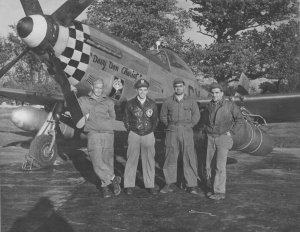
The well known photo of Burlingame’s SX-M (a/c 44-14620) “Davy Don Chariot” rarely has everyone identified. Left to right are Asst Crew Chief Charles B. Perkins, Capt. Gordon S. Burlingame, Armorer Sgt Joseph S. Mortorana and Crew Chief S/Sgt Otto J. Stopen.
A/C 42-103363 p-51C-5-NT “Lucky Leaky II.” The second aircraft assigned to Lt. John E. Davenport.
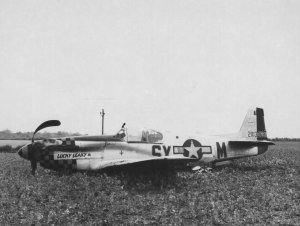
Lt. John E. Davenport’s “Lucky Leaky II” (a/c 42-103363). It came to grief May 2, 1945 after its pilot Lt. Leroy O. Pletz switched fuel tanks and the engine cut.
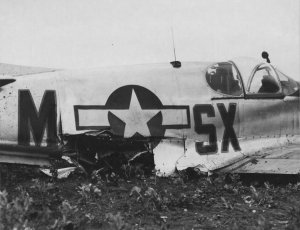
The other side of the very broken “Lucky Leaky II.”
A/C 44-14742 P-51D-10-NA “Gloria Ann 2nd” SX-M. Assigned to Capt. Donald L. Barber.
SX-N
SX-O
SX-P
A/C 42-26036 P-47D-22-RE. Redcoded from SX-B and lost August 1, 1944. The pilot Lt. Delbert Harris became a POW.
SX-Q
A/C 42-25959 P-47D-22-RE. Assigned to the Squadron July 1945 for training purposes. A picture is available on the Jeffrey L. Ethel photo collection website and credits the aircraft as formerly belonging to Lt Bill Parker, but I have no current information to confirm this.
SX-R
A/C 42-7985 P-47D-2-RE. We have not seen any evidence to confirm that this aircraft was assigned to Morrison or named by him – though he may well have flown it on early missions. There is a picture of this aircraft (with no name showing) on p.29 of Jerry Scutts, Lion in the Sky (Wellingborough, 1987). Lt. F. Hajosy was killed in this aircraft when it crashed at Metfield September, 18, 1943.

The first SX-R (a/c 42-7985) was lost when Lt. Hajosy crashed and was killed at Metfield September 18, 1943.
A/C 42-8687 P-47D-5-RE “Hi-Lander.” This was Lt. Morrison’s aircraft though I do not know the origin of the name. The aircraft was salvaged by the 10th Air Depot Group, 9th AF on August 15, 1944, but we have been unable to identify which 9th AF Group it then went to.
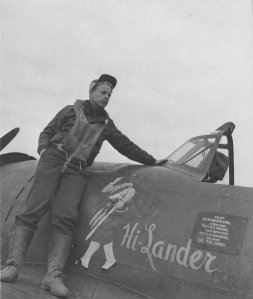
The well known shot of Lt. Morrison’s SX-R “Hi-Lander” (a/c 42-8687). Crew Chief S/Sgt. R. E. Moore, Asst C.C. Sgt. E. H. Gardner and Armourer Sgt. T. H. Jones.
A/C 42-75552 P-47D-5-RE. The earliest reference to this aircraft indicates that it was with the Squadron by April 18, 1944. It is sometimes also referred to as “Hi-Lander,” but we have been unable to find any evidence that confirms this. We do have a reference to P-47 SX-R named “Marie” which could possibly be the name given to this aircraft by Morrison. This aircraft was lost while flown by F/O Earl W. Green June 6, 1944.
As a further clarification there are a number of “typos” on the internet associated with this aircraft so caution is required in tracing the history of the airframe. It is sometimes listed as B7-E “Bald Eagle” of the 374th FS/361st FG, but this was aircraft 42-75522 (as per combat report April 1944). It is also sometimes listed as also being OI-X of the 356th FG and HL-N of the 78th FG. QI-X was actually 42-75522 while HL-N was 42-25552. Whilst we do not know the history of the SX-R before it joined the 352nd we are confident that none of these are the same aircraft (subsequent to this post Peter Randall confirmed that 42-75552 flew with the 361st FG prior to the 353rd).
A/C 42-26665 P-47D-25-RE “Buzz Bunny.” Lt. Morrison flew the final two missions of his first tour in SX-R on June 12 and 14, 1944 after the previous SX-R was lost. Thus Morrison probably flew this aircraft, but it was named and flown almost exclusively between July and October 1944 By Lt. Thomas W. Jones. There is a picture of this aircraft (without name) on p.207 of Danny Morris, Aces and Wingmen II Volume I (Usk, 1989). The aircraft left the Group when they converted to Mustangs and was lost with Lt. William J Gray of 391st FS, 366 FG 9th AF April 16, 1945.
A/C 44-14804 P-51D-10-NA “El Gato” (Capt. Maurice Morrison) and “Honey Bee II” (Lt. Harold Miller). This was the only P-51 to fly as SX-R between October 1944 and the end of the war. It logged 84 missions with 32 different pilots (31 with Morrison and 5 with Miller). Morrison named the aircraft “El Gato” (Spanish for The Cat) after returning eight times either badly shot up or after another worrying experience. When he was assigned a P-51 he felt he was on his ninth life. The artwork is sometimes mistaken for an alligator (probably helped by the name) but as illustrations show it is clearly a panther (i.e. a cat). Further pictures are on p.208 of Morris’s Aces and Wingmen.
As a final note, the crew on SX-R throughout the war was: Crew Chief S/Sgt. Ralph E. Moore, Asst CC Sgt. E. H. Gardner and Armourer Sgt. T. H. Jones. Morris names Ralph Morrow as the crew chief – as there is no recorded crew chief by that name in the 352nd we assume it is a typo or Ralph Moore later changed his name.
SX-S
SX-T
SX-U
A/C 44-15388 P51D-20-NA ‘Stasia.’ Personal aircraft of Lt. Anthony R. Rosatone. The aircraft was lost, along with its pilot 1st Lt. James F. Cross, on November 27, 1944. Nobody saw what happened, but an enemy fighter attack was suspected.
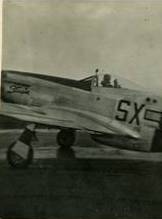
Lt. Rosatone’s ‘Stasia’
A/C 44-15587 P51D-15NA ‘Stasia II.’ Personal aircraft of Lt. Anthony R. Rosatone. Lt. Rosatone was lost in this aircraft January 18, 1945. The weather was extremely bad and nobody was able to report what happened to him.

Lt Anthony R. Rosatone’s ‘Stasia II’ P-51D-15-NA 44-15587
SX-V
SX-W
SX-X
A/C 44-14802 P-51D-15-NA “Miss Illini III.” Aircraft assigned to Capt. Horace Q. Waggoner. There is a photo of the righthand side of this aircraft on page 249 of Jonah’s Feet Are Dry.
SX-Y
A/C SX-Y 42-22465 P-47D-2-RA ‘Scotty Bill’ This is the first SX-Y assigned to Lt William F. Streit. Like the second, the name featured on the right side of the aircraft only. It was also in a different style to the second.
A/C SX-Y 42-76195 p-47D-15RE ‘Scotty Bill’ assigned to Lt William F. Streit. As a D-15, this aircraft would have replaced Streit’s earlier aircraft late Feburary/March, 1944. The aircraft suffered battle damage from an FW190 while Streit was flying it on May 11, 1944 (see JFAD p477).

The well known photo of SX-Y (a/c 42-76195) with L to R S/Sgt L Nelson (Asst Crew Chief), S/Sgt Commodore Collins (Crew Chief), Lt William Streit and Sgt J Hogan (Armorer).
SX-Z
A/C 42-7905 P-47D-1-RE. This olive drab razorback has caused some problems and required a bit of checking. MACR 541 detailing the loss of F/O Earl W. Perry on September 6, 1943 was incorrect in recording the aircraft number as 42-7901 as this aircraft was assigned to the 4th Fighter Group (as WD-G detailed in a Combat Report July 30, 1943) at least between July 1943 and February 1944. The Cumulative Loss Listing, Individual Aircraft Record Card and abort records all confirm that Perry was actually lost in 42-7905. I do not think that this was Perry’s assigned aircraft as I have a letter from Sgt. Welbourn, the Crew Chief, stating that his aircraft was SX-N. It might be that the “N” was put on its side in his memory over the passage of time, but I cannot be any more conclusive than this pending any further photographs or evidence being found.
A/C 42-22762 P-47D-4-RA. This olive drab razorback was presumably a replacement for the first SX-Z lost with F/O Perry and was flying with the Squadron from at least December 4, 1943. It was flown regularly by Lt. Harry H. Dustin but we have no confirmation of any name he gave the aircraft. At some point, probably mid to late February when D-15s came into the Squadron, the aircraft was transferred to the 56th Fighter Group. Combat reports from that Group (March 8 and April 15, 1944) confirm it flew as UN-S with the 63rd Fighter Squadron. The aircraft was then transferred to the 390th Fighter Squadron, 366th Fighter Group of the 9th Air Force. It was lost July 26, 1944 with Lt. Robert L. Ackerly who became a POW (MACR 7482 refers).
A/C 42-75683 P-47D-15-RE. This olive drab razorback was possibly swapped with the 56th Fighter Group for the above aircraft as it is listed by them as transferred to the 352nd FS (no date given). The aircraft was flown by Lt. Harry H. Dustin until he was MIA March 16, 1944. The aircraft was then assigned to Lt. William S. Marchant with the name “Big Totsy” though I cannot confirm whether he inherited the name from Dustin or named the aircraft himself. The artwork was of a woman in cowboy boots and a Stetson just by the cockpit. The aircraft was lost with Lt. Francis L. Edwards on May 30, 1944 (MACR 5205 refers).
A/C 42-26549 P-47D-25-RE. This natural metal finish bubbletop was the assigned aircraft of Lt. Edward C. Andrews and named “Eager Eddie” by him. Andrews flew the aircraft on 50 missions between June and the end of August 1944 and it was then inherited by Lt. Harold E. Nance who flew it on missions until the Group converted to Mustangs in October 1944. Nance said of the aircraft “It had Eager Eddie painted on the side when I inherited it…As I went by the name Ed at the time and he [Andrews] had good luck and finished his tour, I left the name on.” Nance never mentioned to me that he ever had the additional name “Nance” on the aircraft (other than presumably the nameplate on the side of the aircraft). Neither does the photographic and documentary evidence available to me suggest this additional name was ever used. The aircraft suffered an abort due to an oil leak on August 11 and then is recorded as being in the hanger for an engine change on August 14, 1944. After that the documentary trail goes cold and we do not know what happened to the aircraft after it left the 352nd Fighter Squadron. There are numerous photos of this aircraft in Cross’s Jonah’s Feet Are Dry (see p. 120 and 210). There is also a photo in Bill Hess, Aces and Wingmen II – Volume II (Usk, 1999), p.122.
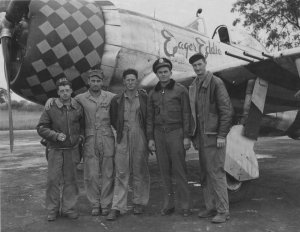
An interesting photo showing the fourth SX-Z (a/c 42-26549) in the hands of Lt. Edward C. Andrews (fourth from left). Far right is Sgt Gladden the crew Chief and on Andrew’s right is Sgt. Nicholson, his Assistant Crew Chief. The other men are Sgt. Harold L. Gibson (far left) and next to him S/Sgt Florian J. Robosky. Robosky was Crew Chief for SX-T in “C” Flight and Gibson his assistant. You can often spot Gibson in photos because of his distinctive “Gibby” cap.
A/C 44-14259 P-51D-10-NA. This aircraft was assigned to Lt. Harold E. Nance and named “Poopdeck Pappy” by him. On the origins of the name Nance wrote: “I named Poopdeck Pappy for my father. At the time Popeye’s father appeared in the comic strip and he was called Poopdeck Pappy and I got in the habit of calling my Dad that name.” The aircraft was flown on 25 missions by 13 different pilots (nine of them by Nance). It was destroyed in a crash at Raydon November 26, 1944 when the pilot, Lt. Stephen J. Kritz, attempted an emergency landing after the engine suffered a coolant leak. Nance also commented on this tragic loss: “A new pilot on his first mission [actually his sixth] took my P-51. After take-off his element leader said the cockpit appeared to be filled with fog or smoke and the pilot augured in within sight of the field. I didn’t even know his name.” Nance completed his tour and left the Squadron in early January 1945.
A/C 44-15691 P-51D-15-NA. This aircraft was flown on 36 missions by eight different pilots between December 18, 1944 and March 2, 1945. As 28 of these missions were flown by Lt. Joseph L. Schreiber it seems safe to assume that it was his aircraft and that he was responsible for the name “L’il Shirl.” The aircraft was lost March 2, 1945 when Lt. Schreiber was shot down by enemy fighters and became a POW (MACR 12864 refers).
A/C 44-14805 P-51D-10-NA. The final aircraft to carry this code in the Squadron was the former SX-L transferred to “C” Flight of the 352nd on March 14, 1945 and re-coded to SX-Z. As Lt. Ralph B. Snyder’s aircraft it was flown on 24 missions by 12 different pilots between March 17, 1945 and the end of the war (six by Snyder). We do not have any confirmed evidence of names for the aircraft in Snyder’s hands. I have “lists” from many sources going back some 30 years with references to both “Shirley Dean” and “Brad’s Dad,” but have no photographic confirmation. Interestingly, Ralph Snyder became a well known TV presenter after the war and details of his career can be found HERE. A search of the internet also confirms that he had a son named Brad – so maybe Brad is out there and can confirm the aircraft name? The aircraft was completely lost as SX-Z in the fatal crash of Lt. Donald F. Blaicher on July 12, 1945.
There is no recorded use of the code SX-Z Bar in the Squadron.
The code SX-Z appears to have been associated with “C” flight throughout the war. The crew for much of that time was S/Sgt. Harold H. Gladden (Crew Chief), Sgt. John W. Nicholson (Assistant Crew Chief) and Sgt. Eugene H. Ploger (Armourer). SX-Y, T and P (at least) were also in “C” flight and it does appear that the crew chiefs at least were sometimes swapped around. As the Nance photo shows S/Sgt Lloyd C. Nelson was his crew chief (he had previously assisted on SX-Y) and 352nd records note the S/Sgt Gladden was given SX-P on September 8, 1944. It is not definitely known therefore who the crew for the later SX-Zs were.
Serial Numbers without Codes
A/C 42-7977 P-47D-2RE Crashed by Lt William M. Mathias June 24, 1943.
A/C 41-6586 P-47C Crashed by Lt Harry H McPherson July 24, 1943.
A/C 42-7912 P-47D-1RE Crashed by Lt Jack D. Lepird July 24, 1943.
Names without Codes/Serials



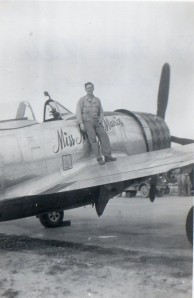

i am looking for a pilot named ben williams who flew p51a in ww2 then flew for continental airlines up to 1985 out of dallas tx is he still alive ths bill miller contintntal ir lines retired
Leslie P Cless, Powell, Wy. POW Nov, 44. Ac144-14831,
Any information would be appreciated.
G. Conner Capt, USAF
SX-U Aircraft: AC 42-76394 was the personal aircraft of Capt. Jesse Gonnam and was lost on Apr 23, 1944 when Capt Gonnam was shot down while on a strafing/bombing mission near Achmer. He spent the rest of the war as a POW in Stalag Luft III. The ac was named “Gwen” after his wife. I have a couple of photos of the plane and a couple of combat art drawings of the plane done by Christian Dieppedalle of France I would be willing to share.
Kerry Gonnam (nephew of Jesse)